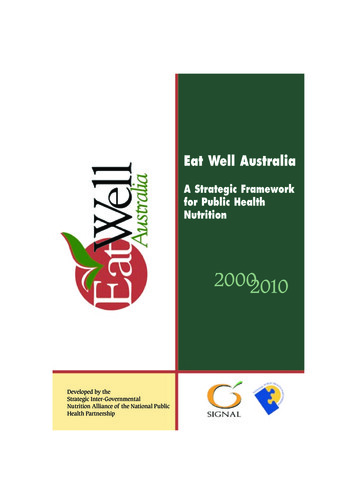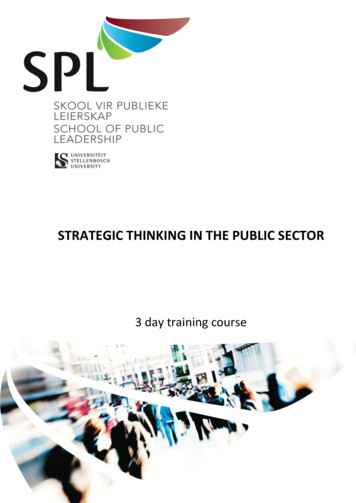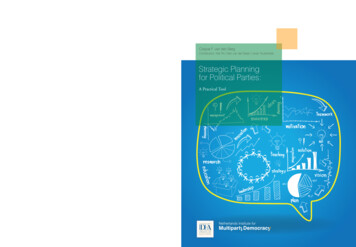
Transcription
Eat Well AustraliaA Strategic Frameworkfor Public HealthNutrition20002010Developed by theStrategic Inter-GovernmentalNutrition Alliance of the National PublicHealth PartnershipATSI A5 Covers22/10/013:38 PMPage 1
AcknowledgementsThe National Public Health Partnership would like to acknowledgethe contribution of the Strategic Inter-Governmental NutritionAlliance (SIGNAL), the EWA Project Team, and all those involved inthe consultation and development of this strategy and action plan.The Australian Health Ministers Conference of 1 August 2001endorsed the national public health nutrition strategy, ‘Eat WellAustralia’ and its Indigenous component the ‘National Aboriginal andTorres Strait Islander Nutrition Strategy and Action Plan (NATSINSAP)’,developed by the Strategic Inter-Governmental Nutrition Alliance ofthe National Public Health Partnership.Copyright: National Public Health Partnership, 2001This work may be produced in whole or in part for research andtraining purposes subject to inclusion of an acknowledgement of thesource and provided no commercial usage or sale is made.Reproduction for purposes other than those indicated above requiresthe written permission of the National Public Health Partnership.Further copies are available by contacting the Strategic InterGovernmental Nutrition Alliance (SIGNAL) Secretariat, email:signal@health.gov.au, website: http://www.nphp.gov.au/signalISBN: 0 642 50342 7Publications Approval Number: 2947
CONTENTSAbbreviations and acronyms2Part A – Overview3Context and background3Why invest in good nutrition?4Common interests and collaborative action6Guiding principles7Structure and scope7Tracking progress8Next steps for key partners9Part B – Strategic Directions111. Health gain111.1 Promoting vegetables and fruit consumption121.2 Promoting healthy weight131.3 Promoting good nutrition for mothers and infants151.4 Promoting good nutrition for school-aged children171.5 Improving nutrition for vulnerable groups181.6 Addressing structural barriers to safe and healthy food202. Capacity building212.1 Investing in public health nutrition research212.2 Improving the effectiveness of interventions232.3 Building human resource capacity252.4 Communicating with the public263. Strategic management283.1 Steering and developing Eat Well Australia283.2 Developing nutrition policy and resources303.3 Monitoring progress in food and nutrition31Appendix34SIGNAL Membership341
Abbreviations and acronymsABSAustralian Bureau of StatisticsAIHWAustralian Institute of Health and WelfareANZFAAustralia New Zealand Food AuthorityATSICAboriginal and Torres Strait Islander CommissionCSIROCommonwealth Scientific and Industrial ResearchOrganisationDHACCommonwealth Department of Health and Aged CareNACCHONational Aboriginal Community Controlled OrganisationNATSINSAPNational Aboriginal and Torres Strait Islander NutritionStrategy and Action Plan2NFNMSNational Food and Nutrition Monitoring SystemNGONon-Government OrganisationNHMRCNational Health and Medical Research CouncilNPHPNational Public Health PartnershipSIGNALStrategic Inter-Governmental Nutrition Alliance
PART A - OVERVIEWContext and backgroundEat Well Australia aims to improve the health of all Australiansthrough better food and nutrition. This proposed national strategy hasbeen developed by SIGNAL, the nutrition arm of the National PublicHealth Partnership, in recognition of the vital role food and nutritionplays in the health and wellbeing of all people.Poor nutrition impacts on the normal development and potential ofinfants and children; it causes ill-health in adults; and it contributes tothe development of chronic and life-threatening diseases such as heartdisease, diabetes and some cancers.The economic and social costs of poor nutrition are considerable.Obesity, a high fat intake and a low consumption of vegetables andfruit rank along side smoking as the most important preventable causeof ill health in Australia.Improving Australians’diets therefore has the potential to cut healthcare costs and improve quality of life.This strategic framework document provides an overview and summaryof the initiatives detailed in the companion, detailed document EatWell Australia: an agenda for action in public health nutrition2000 –2010.The National Aboriginal and Torres Strait Islander NutritionStrategy and Action Plan (NATSINSAP) has been developed inconcert with Eat Well Australia by a working party with Indigenousrepresentation. The two strategies complement each other to providean additional focus for improving the nutrition-related health status ofAustralia’s Indigenous populations.3
Eat Well Australia links to related public health strategies, such asActing on Australia’s Weight, the National Breastfeeding Strategy, theNational Alcohol Plan, the National Mental Health Plan and theNational Diabetes Strategy. It also builds upon and supports the publichealth nutrition strategies of State and Territory jurisdictions, and thecontributions of numerous private sector firms and organisations, nongovernment organisations, researchers, educators and public healthprofessionals.Why invest in good nutrition?There is unequivocal evidence that good nutrition is essential to goodhealth throughout life, and is especially important for infants andchildren.Infants born outside the healthy weight range tend to have higher ratesof ill health in childhood, and possibly later in life. Under-nutrition inyoung children is suspected of contributing to an increased risk ofobesity, diabetes, hypertension, cardiovascular disease, and renaldisease in adult life. Some research suggests intra-uterine nutrition isalso significant. Conversely, the increasing prevalence of overweightand obesity in childhood is also of concern.Recent studies have quantified the burden of disease in Australia bycalculating the number of Disability Adjusted Life Years (DALY) forspecific conditions and risk factors.1 ,2 Tobacco consumption isestimated to be responsible for 9.8% of total DALY. In comparison,nutrition also accounts for at least 10%, for example through obesity(4.7%), inadequate consumption of vegetables and fruit (2.8%) and highblood cholesterol (2.1%).1 Public Health Division, Department of Human Services; (1999) The Victorian Burden ofDisease Study: morbidity, State Government, Victoria: Melbourne.2 Mallor, C; Vos, T; Stevenson, C; (1999) The Burden of Disease and Injury in Australia:summary report, Canberra: AIHW.4
Poor nutrition is a particular problem for Aboriginal and Torres StraitIslander peoples. For example, Aboriginal mothers are twice as likely togive birth to low birth-weight babies than other Australian mothers (seethe full NATSINSAP document for detailed information on nutrition andAboriginal and Torres Strait Islander peoples).Nutrition issues are also significant in adult life. Eating a varied andhealthy diet and keeping physically active can help to maintainindependence in the later years, contributing to vitality and energylevels and to mental health and social functioning. This is increasinglyimportant with an ageing population.Estimates of the direct cost of diet-related diseases in the early 1990’swere of the order of 1.5bn. Adding the indirect costs of lost earningsand premature death brings this figure to over 2.25bn.3 Currentfigures are not available, but are likely to be greater. This figure may nottranslate directly into savings available from improving our diet, but itdoes indicate the scale of the impact of poor nutrition.Although further research and innovation is needed, evidence alreadyconfirms that sound nutrition can have major personal, social andeconomic benefits. A well-nourished and healthy population contributesto economic development and to social and community cohesion.Investing in nutrition can help to contain costs in the health caresystem by reducing pressure on the acute care sector through reducedrates of illness and disease. Good health especially in later years, whena person is more likely to consume higher levels of health services, canreduce demands on services.3 Crowley, S., et al; (1992) The Cost of Diet Related Disease in Australia, Canberra: AIHW.5
Common interests and collaborative actionEat Well Australia has been developed through comprehensiveconsultations with stakeholders across the food and nutrition field: surveys of stakeholders helped identify key issues; interviews gained the insights of key stakeholders; the current literature was reviewed; specialist expertise was sought in many areas; current State and Territory models were reviewed; a draft strategy was disseminated for public comment andsubmissions; seminars were held in each State/Territory to allow discussion andfeedback; and SIGNAL members worked with State/Territory health and nutritionstaff to refine several drafts.With over 400 people consulted, Eat Well Australia provides acomprehensive framework to advance the public health nutritionagenda.Stakeholders have shown enthusiasm and drive about workingtogether on projects of common interest. At both State/Territory andnational levels there are already precedents of strategic partnerships:between industry and government, industry and NGOs, governmentand NGOs, industry and professional groups and public researchagencies.This same process of consensus building was achieved in thedevelopment of NATSINSAP. The Aboriginal and Torres Strait IslanderNutrition Working Party has worked to complement the Eat WellAustralia process, and in consultation with NACCHO and other6
Indigenous groups nationally, has developed the most effectiveapproach to nutrition promotion.Guiding principlesEat Well Australia aims to develop strategic partnerships to improve thefood and nutrition context in Australia and provide Australians withopportunities for better health throughout life. The strategies aim tomake a measurable impact over the next ten years. Eat Well Australia isbased on the following public health principles. It seeks to: make an impact on the whole of the population, not just high riskgroups; combine the efforts of all sectors in a consultative environment; reduce health inequalities and raise the health status ofdisadvantaged groups; acknowledge public and consumer interests; facilitate partnerships based on clear ethics and protocols; provide for the capacity required to achieve success; base initiatives on the available evidence, and develop evidencewhere it is needed; and recognise that a living, sustainable strategy requires continuingresearch, innovation, evaluation and renewal.Structure and scopeThe structure and scope of the detailed document, Eat Well Australia:an agenda for action in public health nutrition, 2000-2010, isambitious and comprehensive. It identifies and describes 26 discreteaction areas, each with a rationale for its inclusion, key objectives,potential partners, capacity requirements, performance indicators,operational links, funding implications and risks.7
To provide a strategic framework of the key nutrition priorities, theaction areas have been collapsed under three broad headings in Part Bof this document and briefly described under 13 strategic directions:Health gain Promoting vegetables and fruit consumption Promoting healthy weight Promoting good nutrition for mothers and infants Promoting good nutrition for school-aged children Improving nutrition for vulnerable groups Addressing structural barriers to safe and healthy foodCapacity building Investing in public health nutrition research Improving the effectiveness of interventions Building human resource capacity Communicating with the publicStrategic management Steering and developing Eat Well Australia Developing nutrition policy and resources Monitoring progress in food and nutritionTracking progressHow will we know if Eat Well Australia is working?Each action area in the companion, detailed document Eat WellAustralia: an agenda for action identifies data needs and proposespotential indicators. Overall, triennial reviews are recommended with amajor evaluation in 2010. The ongoing development of a nationalnutrition and monitoring system is also recommended to help setparameters for evaluation data and provide the information needed fordetailed monitoring.8
Eat Well Australia proposes: setting agreed indicators for each strategy; gathering monitoring evaluation data in real time; providing background and baseline data; and including monitoring and evaluation procedures in partnershipagreements.Next steps for key partnersThe actions summarised in Part B, and described in detail in Eat WellAustralia: an agenda for action, will need to be taken forward inpartnership by organisations across many sectors. Governments have amajor role in taking a lead, developing infrastructure support, andproviding funding where appropriate. But to make a real impact onfood and nutrition in Australia, all relevant organisations, whetherindustry, health, education, professional associations or NGOs, mustmake an effort to progress initiatives in areas within their scope andresponsibility. Potential agencies to progress specific actions aredetailed in the Eat Well Australia: an agenda for action document.Eat Well Australia has been designed as a ‘living’strategic framework.In a changing environment, new opportunities for improvingAustralia’s nutrition will occur and new challenges will arise. Somestrategies will be seen as redundant or unlikely to succeed ascircumstances change; resources and priorities will vary over itslifetime. Eat Well Australia will need to change with these movements,providing an overall coordinating framework, but not tying action to afixed point.The challenge to the nation is to create the vision to support and fund adecade of comprehensive initiatives. It is a vision which spans sectorsand interests and which will benefit all Australians. The potential forreturn on our investment is high, and the risks are readily manageable.9
For some groups, particularly Indigenous Australians, the alternativesare unacceptable.Key partners for Eat Well Australia Commonwealth and State/Territory governments, eg:departments of health, education, agriculture, industry, andtransport10 Government agencies, eg: ANZFA, AIHW, NHMRC, ATSIC Local governments Food industry Professional associations Non-government organisations, eg: health, consumer Health industry, eg: public, private, charitable Health services, eg: general practitioners, health professionals Media Universities and research bodies Community organisations, eg: NACCHO Education services Transport industry Families and individuals
PART B – STRATEGIC DIRECTIONS1. Health gainStrategic directions under Health gain directly address the public healthnutrition priorities of Eat Well Australia. They focus attention andresources in the areas where investment in nutrition can bring thegreatest return in terms of health outcomes. They include:1.1Promoting vegetables and fruit consumption1.2Promoting healthy weight1.3Promoting good nutrition for mothers and infants1.4Promoting good nutrition for school-aged children1.5Improving nutrition for vulnerable groups1.6Addressing structural barriers to safe and healthy food2. Capacity buildingCapacity building refers to the development of the knowledge, practicesand people needed to implement the programs articulated in Eat WellAustralia including:2.1Investing in public health nutrition research2.2Improving the effectiveness of interventions2.3Building human resource capacity2.4Communicating with the public3. Strategic managementStrategic management is essential for Eat Well Australia to develop thepartnerships, systems and positioning for effective promotion,implementation, management and monitoring. Strategic managementincludes:3.1Steering and developing Eat Well Australia11
3.2 Developing nutrition policy and resources3.3 Monitoring progress in food and nutrition1. Health gain1.1 Promoting vegetables and fruit consumptionRationaleThe evidence is growing that consumption of vegetables (includinglegumes) and fruit at the recommended levels (7 serves per day)provides significant protection from ‘lifestyle’diseases. These includeType 2 diabetes, hypertension, heart disease, stroke and cancer. Atpresent, Australians consume an average of 4-5 serves per day, withsome groups consuming significantly less. Increasing both averageconsumption and that of all social groups will have long term benefitsin prevention of these diseases.AimsEat Well Australia aims to increase average consumption per capitaconsumption of vegetables and fruit to five serves of vegetables andtwo serves of fruit a day. This means increasing both the number ofpeople who consume vegetables and fruit every day and the amounteaten.ContextMajor retailers and industry groups, State/Territory Departments andhealth NGOs are already promoting increased consumption ofvegetables and fruit. Professional associations are also important tothis strategy, and the model developed by the Dietitians Association ofAustralia with Coles Australia serves as an example for other potentialpartnerships.12
ActionsFirst priorities include commission market research to inform nutrition promotionprograms; establish a collaborative partnership for national promotion andrelated activities; encourage ‘best buy’program models nationally; develop guidelines for the promotion of vegetables and fruit; work with Indigenous health groups on issues of supply to remotecommunities; map the food supply system, particularly in rural/remote areas toidentify factors which influence supply for vulnerable groups anddevelop strategies to address these; support local and community programs in developing localinitiatives; develop a coordinated approach to the promotion of vegetables andfruit in schools; and develop national and state-based partnerships betweengovernments, industry and NGOs.[Refer also to NATSINSAP action area Food supply in remote and ruralcommunities.]1.2 Promoting healthy weightRationaleAustralia, like other western countries is facing an epidemic ofoverweight and obesity. The number of Australians who are obese hasdoubled in the last ten years, affecting around one in five people.Disturbingly, more Australian children are overweight or obese than atany time in our recorded history. Overweight and obesity is also a13
problem for many Aboriginal and Torres Strait Islander peoples. Urgentaction to reverse this trend is required to avoid placing an increasinglyheavy burden on our social, economic and health systems.The causes and prevention of overweight and obesity are complex.However, it seems that the interplay of inherited tendencies with themodern sedentary lifestyle and changing diet explains the current trend.The evidence suggests that tackling overweight and obesity requires ahigh degree of sensitivity, long-term commitment and cooperativeactions by the public and private sectors. We need to make it easy forpeople to be active and eat a healthy diet throughout life.AimsEat Well Australia aims to halt the trend of increasing overweight andobesity in the Australian community by giving added impetus toimplementing the NHMRC strategic plan Acting on Australia’s Weight;by coordinating action between national strategies that focus onpromoting healthy lifestyles; and by improving clinical treatmentstandards.ContextFurther work by the research sector is needed to identify what willsucceed in preventing overweight and obesity. Partnerships can then bebased on effective strategies combining the resources and actions ofgovernment (health, transport, education, agriculture) with nongovernment organisations and the private sector.ActionsFirst priorities include develop guidelines for the prevention, management and treatmentof obesity in clinical settings and for community-based programs; design and develop model regional or population level projects ;14
develop a communication strategy to increase awareness of theserious impact of overweight and obesity; better align foods eaten outside the home with the DietaryGuidelines for Australians; and reach consensus on systems and tools to monitor trends inoverweight and obesity.[For the actions that focus on preventing obesity in children see 1.4Promoting good nutrition for children. Refer also to NATSINSAP actionareas Food supply in remote and rural communities, Family focusednutrition promotion, and Nutrition issues in urban areas.]1.3 Promoting good nutrition for mothers andinfantsRationaleResearch is continuing to point to maternal and early nutrition asimportant in a person’s health over the whole of their lifespan. Infantsborn outside the healthy weight range tend to have higher rates of illhealth in childhood, and possibly later in life. Low levels of criticalnutrients during pregnancy, such as folate, iron or calcium, are nowaccepted as leading to developmental problems, although other factors,such as alcohol or tobacco are often also present. Breastfeeding hasalso been shown to protect against asthma and infectious and ‘lifestyle’diseases, while inappropriate introduction of solid foods can lead toeither obesity or malnutrition.Poor maternal and infant nutrition is most often associated with lowincome groups, teenage mothers, Indigenous women and some ethnicgroups. Low birth weight babies are a serious problem in someAustralian Aboriginal communities.15
AimsEat Well Australia aims to increase the proportion of babies born withinthe healthy weight range, and the proportion of mothers with adequateintakes of key nutrients, including folate, iron and calcium. It also aimsto increase the number of babies breastfed to six months of age, andthe proportion of mothers introducing solids in line with NHMRCGuidelines. Eat Well Australia focuses on at risk groups, includingIndigenous mothers and infants, for particular attention throughimproved research and interventions at community level.ContextThere are many potential strategic partners in this area, includinghealth services and hospitals, community and maternal groups, thebaby and infant foods industry, Indigenous and special interest groups,research and health professional groups.ActionsFirst priorities include review and promote the best of the many existing programinitiatives from all sectors; develop new measurement standards for breastfeeding and infantgrowth; establish criteria for effective interventions and disseminate goodpractice models; review folate initiatives, assess the state of knowledge on maternalnutrition and the potential for guidelines for pregnant and lactatingwomen; develop policy and programs addressing healthy weight issues foryoung children; resource, develop and evaluate Indigenous access and participationin antenatal and postnatal care programs; and16
support initiatives such as the Baby Friendly Hospital initiative.[Refer also to NATSINSAP action areas Food supply in remote and ruralcommunities, Family focused nutrition promotion, and The environmentand household infrastructure.]1.4 Promoting good nutrition for school-agedchildrenRationaleThe National Nutrition Survey (1995) found that 23% of children wereat risk of becoming overweight, and in some Indigenous communitiesthe rate is over 17%. Childhood obesity is associated with high-energydiets and low levels of physical activity. Problems relating to poor bodyimage are also on the increase.Children need good nutrition to develop and grow to their potential, tobe protected against chronic disease in later life, and to participate incultural life around food. Educating them about preparing food, healthyeating and the social role of food will help promote good eating habitsinto adulthood. Finding ways of doing this cross-culturally is aparticular challenge.AimsEat Well Australia seeks to increase the number of children who fallwithin the healthy weight range by promoting good eating habits andphysical activity. It also aims to increase the availability of healthymeals and snacks for children in schools, care centres and otherinstitutional settings. More broadly, it seeks to promote positiveattitudes to food and body image among children.ContextGovernments will continue to work with the many groups alreadyactive in this field, such as the Health Promoting Schools Association ofAustralia, Home Economics Institute of Australia, school canteen17
associations, sporting, education, youth, public and dental health andrelated professional groups.ActionsFirst priorities include: identify best practice programs and materials across a range ofsettings, issues and age groups, and disseminate information aboutthese programs; review research on food advertising and the adequacy of theTelevision Advertising Code for Children and recommend anychanges to the code, compliance monitoring of other relatedpractices; review food supply strategies for school canteens and identify anyappropriate support; develop best practices in preventing eating disorders and supportdemonstration initiatives; and assess funding options targeting children at risk.[Refer also to NATSINSAP action areas Food supply in remote and ruralcommunities, Family focused nutrition promotion, and The environmentand household infrastructure.]1.5 Improving nutrition for vulnerable groupsRationaleSome Australians find it difficult to obtain enough food, and the rightfood important to living active and healthy lives. This can be a chronicproblem or occur only at certain times. Those who are poor, socially orphysically isolated, frail, elderly, chronically ill or living with a disabilityare especially vulnerable. For many people these factors readilycompound, so they are at greater risk of poor nutrition.18
Ensuring that vulnerable people have access to enough and goodquality food is a complex issue. Welfare agencies currently struggle toprovide high quality food to all those in need. Some people receivinggovernment services may have food and nutrition problems that areunrecognised. Many agencies working with these groups do not havesufficient expertise or resources to provide optimal food and nutritionservices.AimsEat Well Australia aims to influence services, work practices andpolicies of agencies that have contact with vulnerable people and soimprove their clients’access to adequate amounts of nutritious food.ContextGovernment and non-government agencies with expertise in relevantfields - from the welfare sector at a national and the community sectorat a local level - make a concerted effort with established and ongoingprograms to address the health needs of vulnerable groups. Thesegroups include the elderly, those on low incomes, people withdisabilities, chronically ill people, and Aboriginal and Torres StraitIslander peoples.ActionsFirst priorities include: review the range of existing services, identify where services impacton food and nutrition and recommend organisational changes,training needs and resource requirements; disseminate resources and models of effective food and nutritioninitiatives for vulnerable people across jurisdictions and sectors; provide nutrition information and support to welfare providers;19
develop nutritional guidelines for agencies that provide mealservices for vulnerable groups and recommend ways to ensure theyare adopted; and provide expert advice on nutrition training needs to the communityservices sector as opportunities arise.[Refer to NATSINSAP for detailed actions addressing Aboriginal andTorres Strait Islander nutrition needs]1.6 Addressing structural barriers to safe and healthyfoodRationaleThe food Australians eat is not simply a matter of personal choice orknowledge. Policies and social, physical and economic factors allinfluence the food people eat. Some of these factors are town planningnorms, public transport, food supply systems and transport costs, foodadvertising practices, competitive prices for food and user friendlyshopping.AimsEat Well Australia aims to influence all relevant policies and practicesso that all Australians have access to safe, affordable and culturallyappropriate food.ContextVulnerable groups are particularly affected by structural factors orpolicies that impact on their income, the food supply, access to servicesand the cost of food. For example, food is often more expensive andthere is less choice in rural and remote places.Activities like promoting vegetables and fruit consumption will be moresuccessful for certain groups if structural factors that limit theavailability of product or increase prices are also addressed.20
ActionsFirst priorities include: disseminate advice on the potential impact of relevant policies, sothat they take account of nutrition issues; develop bipartisan government support for initiatives that addressstructural barriers to food access; identify actions that retailers, food manufacturers and privatetransport can take; recognise and publicly congratulate organisations that change theirpractices; consider a remote food subsidies program by governments incollaboration with non-health government agencies and the privatesector; improve access to healthy food including traditional foods forIndigenous peoples; and review and disseminate evidence on ways to address local structuralbarriers that impact on the consumption of healthy food.[Refer also to NATSINSAP action areas Food supply in remote and ruralcommunities and The environment and household infrastructure.]2. Capacity building2.1 Investing in public health nutrition researchRationaleInvesting in agreed public health nutrition priorities is essential so thatEat Well Australia’s activities are based on the best available researchevidence. Investment may come from both government and privatesectors, and the results will inform decision-makers in all sectors.Research into good practice will also give nutrition workers the tools
healthy diet and keeping physically active can help to maintain independence in the later years, contributing to vitality and energy levels and to mental health and social functioning. This is increasingly important with an ageing population. Estimates of the direct cost of diet-related diseases in the early 1990' s were of the order of 1.5bn.











